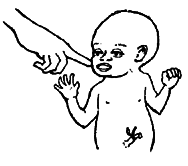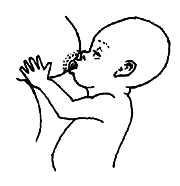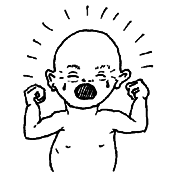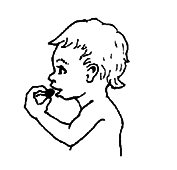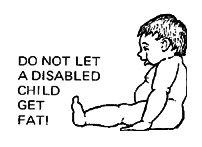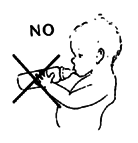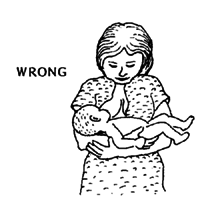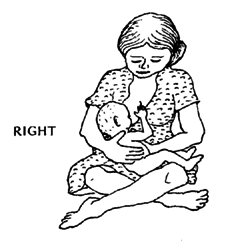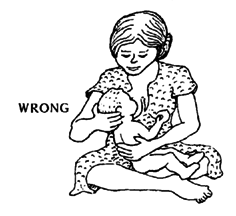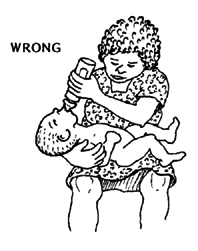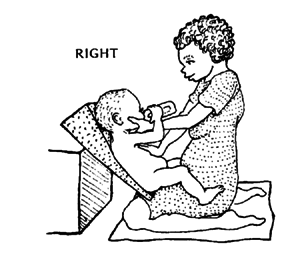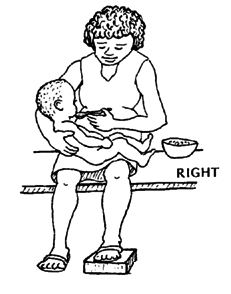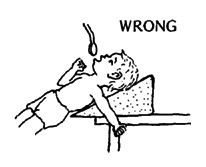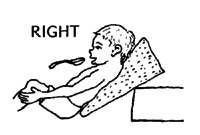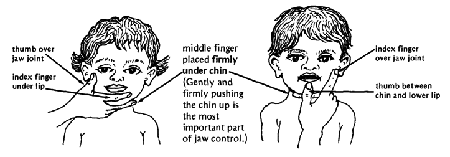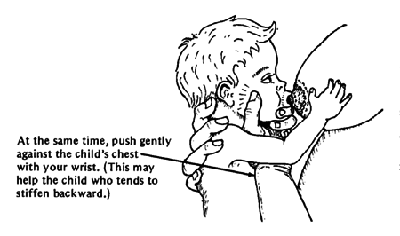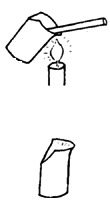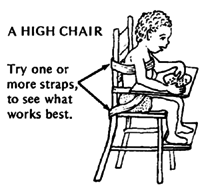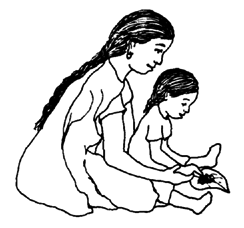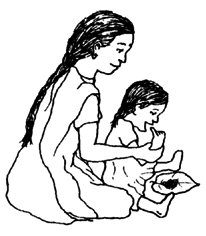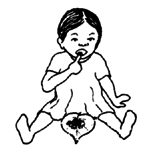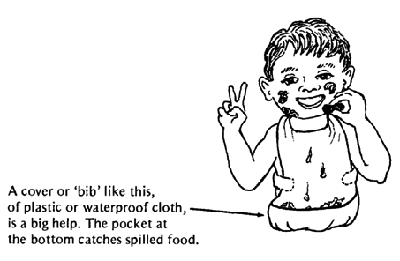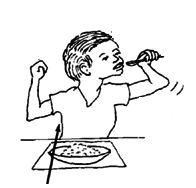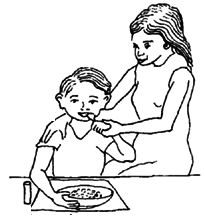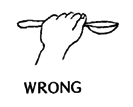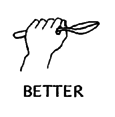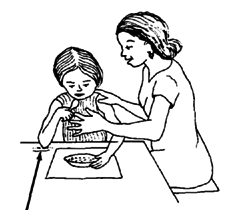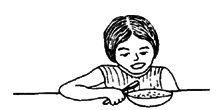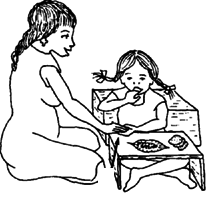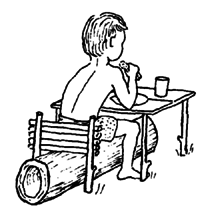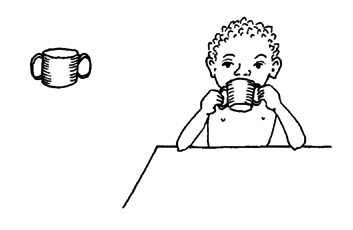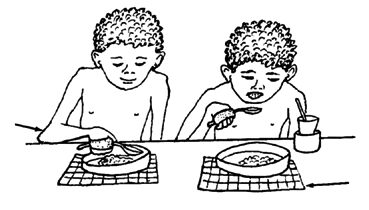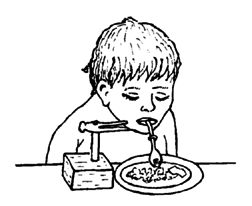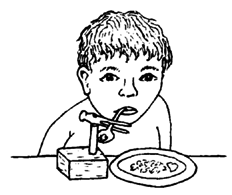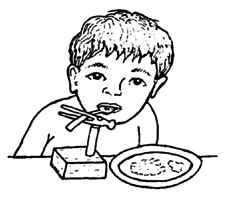Disabled Village Children
A guide for community health workers,
rehabilitation workers, and families.
PART 1
WORKING WITH THE CHILD AND FAMILY:
Information on different Disabilities
D. Helping Children Develop and Become More Self-reliant
CHAPTER 36
Feeding
![]()
Feeding is one of the first abilities that a child develops to meet her needs. Even a newborn baby has reflexes that cause her to:
|
turn her head to seek the breast when her cheek is touched,
|
|
suck and swallow,
|
|
and cry when hungry.
|
|
By a few months of age, the child learns to take solid food in her mouth and eat it.
|
Normally a child's feeding skills gradually increase without any special training. She learns first to use her lips and tongue to suck and swallow liquids. Later she learns to bite and chew solid foods, and to take food to her mouth with her hands. The early head-turning and sucking reflexes gradually go away as she learns to control her feeding movements.
Some children, however, do not develop feeding skills easily or naturally. This may be because the child's whole development is slow (retarded). Or, because the child has a particular physical difficulty (such as a hole in the roof of her mouth-see "Cleft Palate," Page 120).
![]()
Children with cerebral palsy often have feeding difficulties, which are sometimes severe. Difficulty with sucking (or being unable to suck) may be the first sign in a child who later develops other signs of cerebral palsy. Or the child may have trouble swallowing, and easily choke on food. Uncontrolled movements of the body, pushing out the tongue, or floppy, inactive lips may also be a problem.
One reason that some disabled children are slow to develop self-feeding skills is that their families continue to do everything for them. Because of a child's other difficulties, her family may continue to treat her as a baby. They may give her only liquids, and put everything into her mouth, rather than encouraging her to do more for herself.
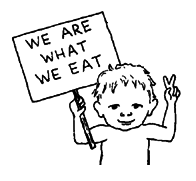
REMEMBER: Helping the child develop feeding skills as early as possible is of special importance because good nutrition is essential for health and life. The food needs of a disabled child are the same as for any child. Good use of the lips and tongue when feeding is also important for future speech. |
POOR NUTRITION IN DISABLED CHILDREN
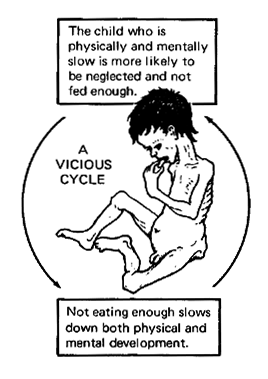
Poor nutrition or 'malnutrition' usually results from not getting enough to eat and is one of the most common causes of health problems. With its signs of weakness, thinness, failure to grow, and reduced ability to fight off illness, poor nutrition might be considered a 'disability' itself. It affects at least 1 out of every 6 of the world's children, mainly those who live in poor countries.
In this book, we do not discuss the problems of malnutrition in detail, because they are covered in most primary care handbooks (see Where There Is No Doctor, Chapter 11). However, a special warning is called for.
|
WARNING: Disabled children are often in greater danger of malnutrition than are other children. |
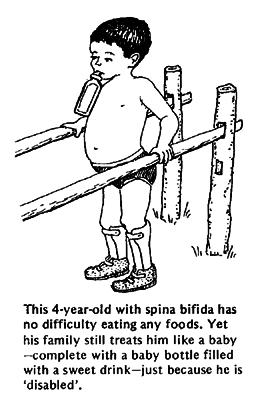
Sometimes this is because the child has difficulty sucking, swallowing, or holding food. Sometimes it is because the family gives more food to the children who are stronger and more able to help with daily work. Sometimes, however, it is because parents, although they treat their disabled child with extra love and care, keep bottle feeding him (with milk, rice water, or sugared drinks) until he is 3 or 4 years old or older. They keep treating-and feeding-their child like a baby, even though he is growing bigger and needs the same variety and quantity of foods that other children need.
To give a child only-or mainly-milk and sweet drinks after 6 months of age may keep the child fat. But he will slowly become malnourished. Milk and sweet drinks lack iron, so that the child may become more and more pale, or anemic (weak blood).
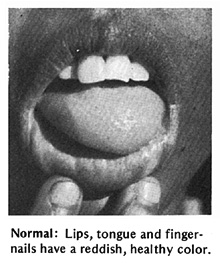
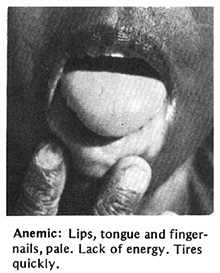
|
REMEMBER: A disabled child needs the same foods that other children of the same age need. |
|
CAUTION: It is important that disabled children get enough to eat. It is also important that they do not eat too much and get fat. Extra weight makes it more difficult for a weak child to move about. If the child is getting fat, give him less fatty foods and sweets.
|
THE BEST FOOD FOR YOUR YOUNG CHILD
THE FIRST 4 TO 6 MONTHS
Give breast milk and nothing else.
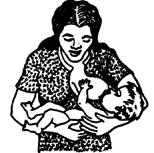
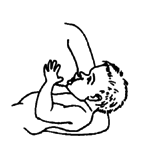
BREAST IS BEST because breast milk contains the ideal combination of foods that the child needs, is clean, and is always the right temperature. Also, breast milk contains 'antibodies' from the mother that protect the baby against infections.
Therefore, breast milk is especially important for children more likely to get infections, such as a child with Down syndrome (see Page 279) or a child who often chokes on her food and might get pneumonia.
|
Breast milk is healthier for babies than other milks or 'formula'. |
If the baby cannot suck, a mother can milk her breasts:

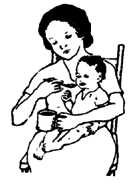
And then give the baby her milk with a cup and spoon.
|
WARNING: Avoid baby bottles whenever possible. They often spread infections.
Cup and spoon feeding is safer. |
FROM 4 TO 6 MONTHS AND AFTER
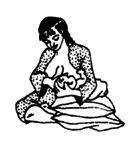
Continue breast feeding and also begin to give the baby other foods-juices and fruits rich in vitamins, mash of green leafy vegetables beans (boiled, skinned, and mashed), peanuts (skinned and mashed), egg yolks, and other local staples such as rice, corn, plantains, or cassava.
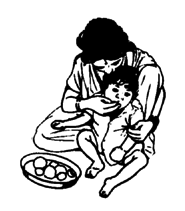
|
Small stomachs need food often. Feed children under 1 year old at least 5 times a day-and give them snacks between meals. |
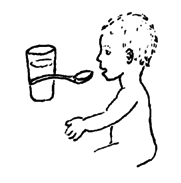
If the child has trouble eating solid foods, do not keep giving only milk or formula or 'rice water'. Even mother's milk alone is not enough after 6 months.

Mash or grind up other foods to form a drink or mush.
|
By 8 months to 1 year of age the child should be eating the same food as the rest of the family - even if it has to be mashed or turned into liquids. |
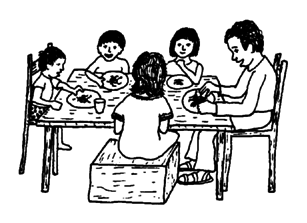
Successful feeding involves the whole child
![]()
The more difficult it is for a child to control his body movements, the more difficult it will be for him to feed himself. A child with Down syndrome may have trouble feeding because of weak mouth and lips and poor head control. But the feeding problems of a child with cerebral palsy are more complex. They may include: lack of mouth, head, and body control; poor sitting balance; difficulty bending hips enough to reach forward; poor hand-eye coordination; and difficulty holding things and taking them to his mouth. We must consider all these things when trying to help the child feed more effectively.
It is not enough simply to put food or pour drink into the mouth of a child who has difficulty sucking, eating, and drinking. First, we must look for ways to help the child learn to suck, swallow, eat, and drink more normally and effectively. Here are some suggestions.
POSITIONS FOR FEEDING
Be sure the child is in a good position before you begin feeding her. The position will make feeding either easier and safer, or more difficult and unsafe.
![]()
|
Do not feed the baby while she is lying on her back because this increases the chance of choking. In a child with cerebral palsy, it often causes backward stiffening, and makes sucking and swallowing more difficult.
|
|
Feed the baby in a half sitting position with her head bent slightly forward. In a child with cerebral palsy, to keep the head from pushing back, hold the shoulders forward, keep the hips bent, and push firmly on the chest.
|
|
Do not let the head tilt backward. It makes swallowing harder and may cause choking. In a child with cerebral palsy, avoid pushing the head forward like this. It will cause the baby to push her head back more forcefully.
|
Positions for feeding with a bottle, spoon, or finger are like those for breast feeding.
![]()
|
If the baby does not suck and swallow well, the mother may think she should put a bigger hole in the nipple, tilt the baby's head back, and pour the milk into the baby's mouth
But this may choke him, and it does not help him learn to suck well. |
|
Position the baby so that the head is slightly forward, and the bottle comes from in front, not above. Pushing gently on the chest helps stop backward stiffening so the baby can swallow better. If possible, have baby hold bottle.
|
|
To avoid the backward stiffening, bend the shoulders and back forward, keeping the hips and knees bent. Be sure the head bends a little forward. Place food below and in front of child, not above or behind him.
foot lift to keep the baby's knees higher |
![]()
A simple 'baby seat' can help the baby hold a good position while eating. Here is one idea using an old plastic bucket.
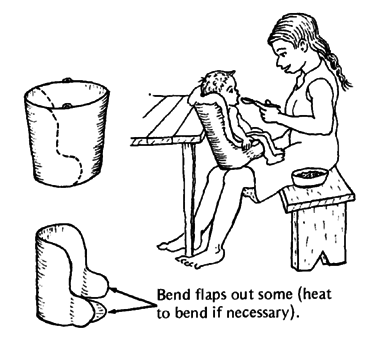
For other sweating ideas, see Page 326.
|
REMEMBER: When feeding a child with cerebral palsy,
giving food from above often causes the head to press back and body to stiffen. It makes swallowing difficult.
Giving food from in front helps stop stiffness and makes eating and swallowing easier. |
![]()
HELPING CONTROL MOUTH FUNCTION
The child may also need help in improving the sucking-swallowing reflex, and her ability to eat from a hand or spoon and to drink from a cup. Sometimes these can be improved by using what is called 'jaw control'.
Jaw control. Before giving the breast, bottle, spoon or cup, place your hand over the child's jaw, like this:
|
if you sit beside the child |
if the child is facing you |
|
|
|
At first the child may push against your hand, but after she gets used to it, it should help her control the movement of her mouth and tongue. Be sure not to push her head back, but keep it bent forward slightly.
While you feed the child, apply gentle, firm steady pressure - not off and on.
![]()
Good positioning together with jaw control will help with several problems common in cerebral palsy, such as pushing the tongue forward, choking, and drooling (dribbling). As mouth control improves, gradually lessen and finally stop jaw control.
For more suggestions for controlling drooling and improving use of the lips and tongue, see the section on developing speech, Page 314.
![]()
|
For the child who has difficulty breast feeding (or bottle feeding), as you apply jaw control try bringing her cheeks forward with your fingers. |
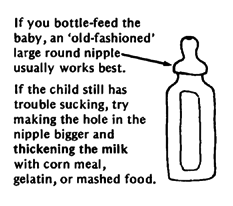
|
![]()
|
CAUTION: Jaw control helps in many children with developmental delay and cerebral palsy-but not all. After trying it for 2 or 3 weeks, if the child still resists it or shows increased problems, stop using jaw control. |
Spoon feeding
The child who has no sucking-swallowing reflex needs to be fed with a spoon.
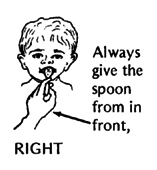
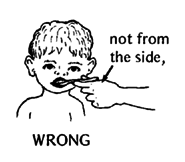
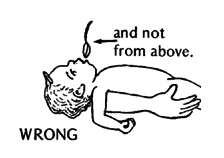
|
The best spoon is rounded and shallow.
Not deep because this makes it hard for the lips to get out the food.
And not long and pointed as this could cause choking. |
'Tongue thrusting'
![]()
A baby sucks by moving her tongue forward and backward. For this reason, when the child begins to eat from a spoon, her tongue will at first push part of the food out of her mouth. She has to learn to use her tongue differently-pushing the food between the gums to chew, and to the back of her mouth to swallow. Children with developmental delay or cerebral palsy may have trouble learning to do this, and continue to push or 'thrust' the tongue forward for some time. Do not mistake this for meaning she does not like the food.
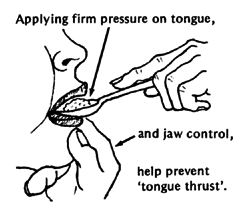
Jaw control, although helpful, may not be enough to prevent this tongue thrusting. It also helps to apply firm pressure with the back of the spoon on the tongue as you feed the child. This helps keep the tongue from pushing forward and lets the child use his lips and tongue better.
|
CAUTION: Better to use a strong (metal) spoon and NOT a thin plastic one that might break when you push down the tongue. |
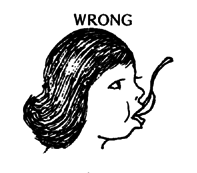
Do NOT scrape the food onto the upper lip or teeth as you take the spoon out. Instead, let the child try to get the food off the spoon onto her tongue. To make it easier for her, start by putting only a little food on the end of the spoon. As you take the spoon out, make sure the mouth is closed so that the tongue can move the food inside the mouth and cannot push it out.
If eating with fingers is the custom, or if spoon feeding is too difficult, use your fingers.
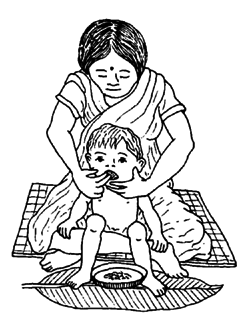
Here a mother holds her child in a good position on her lap, using her legs and body to give support.
With one hand she gives jaw control while she feeds him with the fingers of the other hand. Place a little food on the side or middle of the tongue-not on the front of it.
For spoon or finger feeding, it is best to start off with soft, mushy foods rather than liquids. Milk (even breast milk) or egg yolk can be mixed with rice paste, boiled corn, or mashed beans. You can also give small pieces of fruit, mashed greens and vegetables, and yogurt or soft cheese.
Hardest for the child to eat are combinations of liquids and solids-such as vegetable soup.
|
CAUTION: Remember to wash your hands before feeding child with your fingers. |
Chewing
![]()
To help the child learn to chew, put a bit of firm food in the side of her mouth between her teeth. Use very small pieces of bread crust, tortilla, or chapati. Help her close her mouth using jaw control.
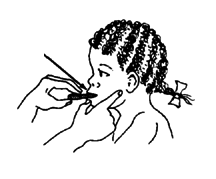
Biting off can be encouraged by pulling slightly on a long thin piece of food.
Or rub the piece of food against the teeth before putting it between them.
|
CAUTION: Do NOT open and close the child's jaw or help her chew. After she bites the food, her jaw must stay closed or almost closed to chew. To help her do this, apply steady firm pressure with jaw control. This should lead the child to make chewing motions. Let the jaw move some on its own. But do NOT make chewing motions for the child! This will only encourage abnormal movements. |
If the child has difficulty chewing and chokes on pieces of food, try this:

Cut a piece of clean, soft cotton cord, or braid thin strips of cotton cloth. Soak or cook the cord in a tasty good food and hold the end while she bites and chews on it, squeezing out the nutritious juices. Help with jaw control.
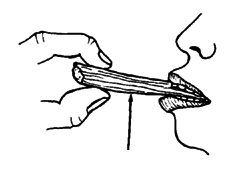
A finger-shaped piece of tough cooked or dried meat or very tough chicken (old rooster) can be used instead of cord. Be sure it is too tough for the child to chew pieces off of it, but juicy or tasty enough to give her pleasure.
This method is completely safe. Because you hold on to the cord, the child cannot bite off pieces and choke on them. It is best to practice this at the beginning of a meal while the child is still hungry.
|
CAUTION: If a piece of food slips back into the child's throat and gets stuck, bend the child far forward, and keep calm. The food should drop out. Do NOT pat the child on the back as this could cause the child to breathe in the food. If the food does not fall out and the child cannot breathe, suddenly and forcefully squeeze the child's lower chest (see Where There Is No Doctor, Page 79). |
![]()
Drinking
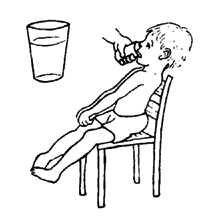
Successful drinking, like eating, involves the whole child. Body position is important. For example, in a child with cerebral palsy, to drink from a regular cup or glass, his head must be tilted back. But this can cause uncontrolled backward stiffening and possible choking.
However, if he uses a plastic cup with a piece cut out, he can drink without bending his head back.
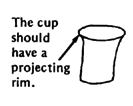
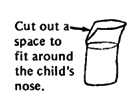
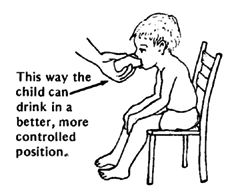
|
You can make a special cup from a plastic bottle.
Cut it like this.
Gently heat the rim and gradually bend it out with a round smooth rod or stick
|
At first you may need to apply jaw control to help the child close her lips on the rim of the cup. Tilt the cup so that the liquid touches the upper lip and let the child do the rest. Do NOT take away the cup after each swallow as this may trigger pushing the head back or tongue out. It helps to start with thick liquids-like cooked cereals, maize mush, or yogurt.
![]()
Self-feeding
To be able to feed herself, a child needs more than control of her mouth, lips, and tongue. She also needs to be able to sit with her head up, to pick things up, and to take them to her mouth.
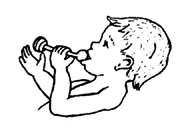
To prepare for self-feeding, encourage the child to play, taking his hands and toys to his mouth. Also, encourage him, when sitting, to balance while he uses both hands (see Page 105 and 307).
A child with poor balance or uncontrolled movements will at first need special seating adapted to her needs.
|
|
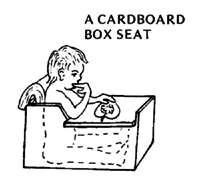
|
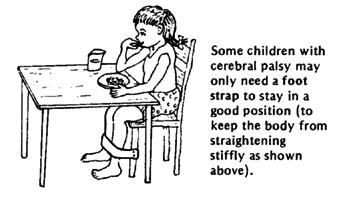
|
|
CAUTION: Seats or straps that limit movement should be used only until the child learns to control her position without being tied or held. Special seating should help the child to do more and to move more freely. It should not become a prison! For more seating ideas, see Page 323, 573, and Chapter 65. |
When a child is slow in using her hands to grasp things, or to take things to her mouth, you can help her discover how to use her hands and feed herself, like this:
|
Put the child's finger in a food she especially likes.
|
|
Then lift her finger to her mouth.
|
|
Help her to do more and more, step by step, until she does it alone.
|
Little by little help her less and less. Lift her hand to her mouth and touch her lips with the food. See if she will then put it into her mouth. When she has learned this, lift her hand near her mouth and see if she will do the rest. Next just put her finger in the food and encourage her to lift it to her mouth. Each time she does more for herself, praise her warmly.
This method is part of a 'behavioral approach' to teaching new skills. The same approach can be used for teaching the child many skills related to eating, such as using a spoon or drinking from a glass. To learn more about this approach, see Chapter 40,"Ways to Improve Learning and Behavior."
|
IMPORTANT: Try to make mealtime a happy time. Remember that it takes time for any child to learn new skills, and that a child learns best when he plays. When any child first learns to eat for himself, he makes a mess. Be patient, help the child to become more skillful at eating, praise him when he does well, but at the same time let him enjoy himself and his food. Remember, even normal children often do not learn to eat cleanly and politely until they are 5 or 6 years old-or even older. |
While it is important not to push or hurry children too much in developing feeding skills, the opposite is also true. Often parents wait too long and do not expect enough from their disabled child. On the next page is a 'trick' that a rehabilitation worker uses to help parents awaken to the ability of their retarded child to learn new skills.
THE 6 MINUTE BISCUIT TRICK FOR DEVELOPMENTALLY DELAYED CHILDREN
by Christine Miles, Mental Health Centre, Peshawar, Pakistan
The 'trick' gets parents to open their eyes to what their child actually can do and learn to do. I see many parents with developmentally delayed children between 15 and 30 months. They have realized that the child is not functioning at a level appropriate for his age. But often they cannot describe what the child actually can do, and do not seem to realize that children gain new skills by learning. Parents complain that "He doesn't speak. He can't do this, he can't do that," as though there is something wrong with the machinery or someone has failed to push the correct button.
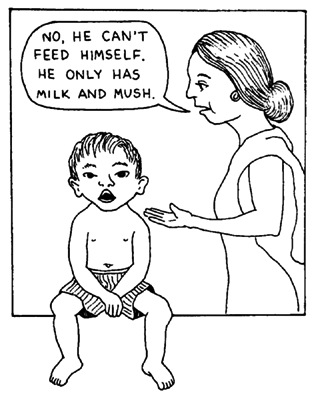
I ask them whether the child can eat a biscuit (cookie). "No, he only has milk and mush. He can't feed himself." I get a biscuit and put it into the child's hand. I guide the hand up to the mouth. Sometimes the child will bite on the biscuit; sometimes it needs to be tapped gently against his teeth and wetted with his lips and tongue until a piece breaks off and is eaten. I move the child's hand away from the mouth, then repeat the process. Usually by the time half the biscuit has gone, the child has learned how to do it, and finishes the biscuit happily without help. The parents usually say "Oooh!"
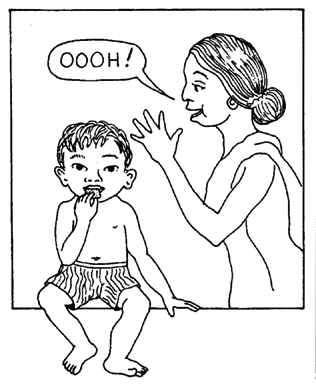
In 6 minutes the parents have watched their child learn an important skill, by our using a simple directed action and a strong reward (tasty food). Whether their child is temporarily delayed in development or will be permanently retarded, the parents gain some vital information about the child's ability to learn. Whether or not they remember anything else that I say to them, they go away with a whole new experience to think about. Almost always they have consulted several doctors before coming here, without gaining any useful advice.
Of course, it is not guaranteed to work. But it does work surprisingly often. The 6 minute biscuit trick is a powerful stimulant to parents to actually observe their child and to help the child learn.
SELF-FEEDING SUGGESTIONS FOR THE CHILD WITH CEREBRAL PALSY
![]()
|
COMMON PROBLEMS |
SUGGESTIONS |
|
|
The less-used arm pulls up and back or moves about. Head twists to side and back. Child has a weak, awkward grip, and poor control of arm movement. Whole body stiffens backward.
|
Help the child to control arm at shoulder.
Have the child hold his hand, first on a post, later on a dish. |
Help him learn to hold the spoon firmly.
|
|
Straighten his hand by turning it out gently from the base of the thumb. |
||
|
Sometimes you can help her with head control by gently pressing one hand flat against her chest.
|
|
Raising the table may make it easier for some children.
|
|
Where the custom is to eat sitting on the floor, a child may be helped by making a low table out of a box.
|
|
When head and body are difficult to control, it may help to sit on a bench or log in a 'riding' position.
If he sits with a rounded back, it may help to support the lower back. |
|
A child who has trouble controlling a cup with one hand can often do better if the cup has two handles.
Ask a local potter to make one. |
Homemade equipment to help eating
A plate with steep sides makes eating easier for the child who uses only one arm. When that arm is very weak, it helps if the dish is low on one side and high on the other, to push food against.
|
This boy, whose arms and hands are paralyzed, lifts his spoon by raising and lowering his shoulder. His forearm is on the table edge, so that when he lowers his elbow, his hand lifts. |
|
A non-slip mat under the plate can be made from strips of tire tube woven over a stiff wire frame. |
The spoon slips into a leather or rubber (tire tube) hand band. (Also, see Page 577.)
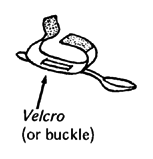
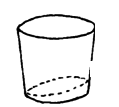
The special plate can be made from a small plastic bucket.

To prevent slipping, you can glue (with a waterproof glue) strips of tire tube on the bottom.
A non-spill cup holder can be made using 2 plastic bottles.
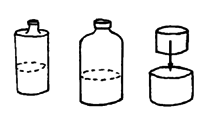
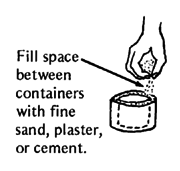
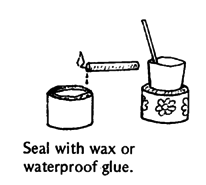
Or, glue a plate or tin to the bottom of the cup.
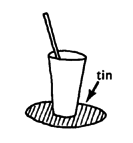
Spoon handles for easy gripping
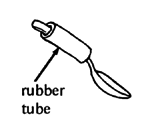
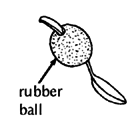
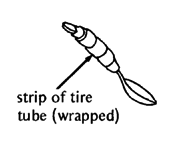
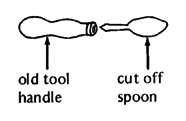
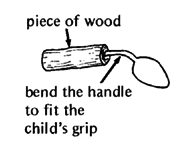
Tortilla or chapati holder
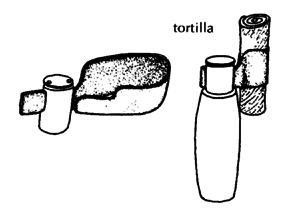
From UPKARAN Manual. (See Page 642.)
From UPKARAN Manual. (See Page 642.)
Swing-a-sling eating aid
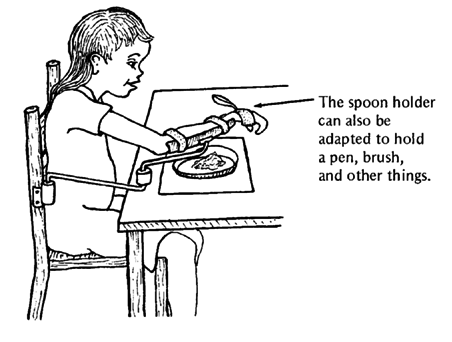
This eating aid lets a child with very little strength in her arm feed herself. However, it must pivot smoothly but firmly at 3 points. It will take a skillful and imaginative craftsperson to make it.
Arm rocker-for a child whose arm is too weak to lift
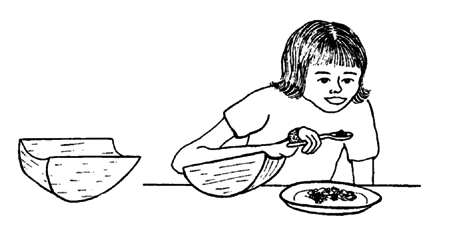
Carve it out of wood-or glue together layers of 'Styrofoam' (stiff foam plastic) or cardboard.
Or make it from the bottom of an old plastic (or metal) bucket.
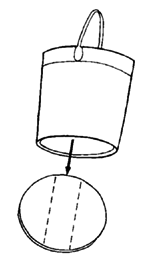
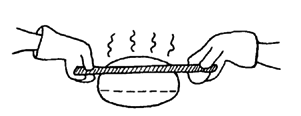
Heat the plastic along the lines with a hot strip of metal.
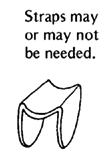
And bend it like this.
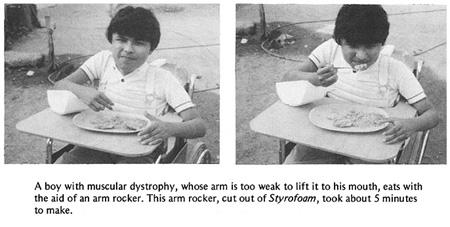
Feeding aids for a child with no hand use
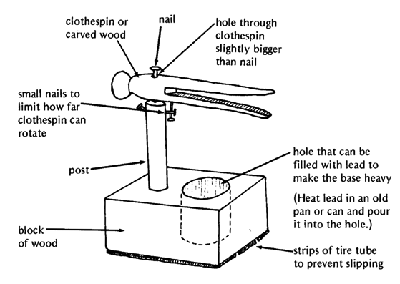
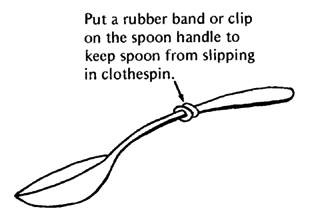
|
Pick up food holding spoon in mouth.
|
|
Slip spoon into clothespin.
|
|
With the lips, turn clothespin so that spoon enters mouth.
|
|
Note: If other children laugh at the child's awkwardness, let him practice alone until he gains some skill. |
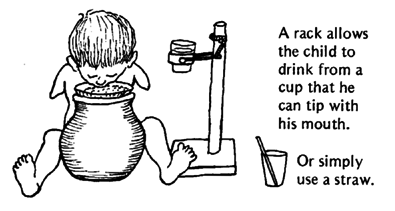
Children with no use of their arms can feed themselves by lowering their mouths to their food. It helps if the plate can be lifted nearer to the face. A pot like this helps to stabilize the plate. If the plate has a rounded bottom, the child can tip it bit by bit as it is emptied.
|
Use your imagination to think of many other ways to help the disabled child eat and do other things for herself. |
Disabled Village Children
A guide for community health workers,
rehabilitation workers, and families
by David Werner
Published by
The Hesperian Foundation
P.O. Box 11577
Berkeley, CA 94712-2577

